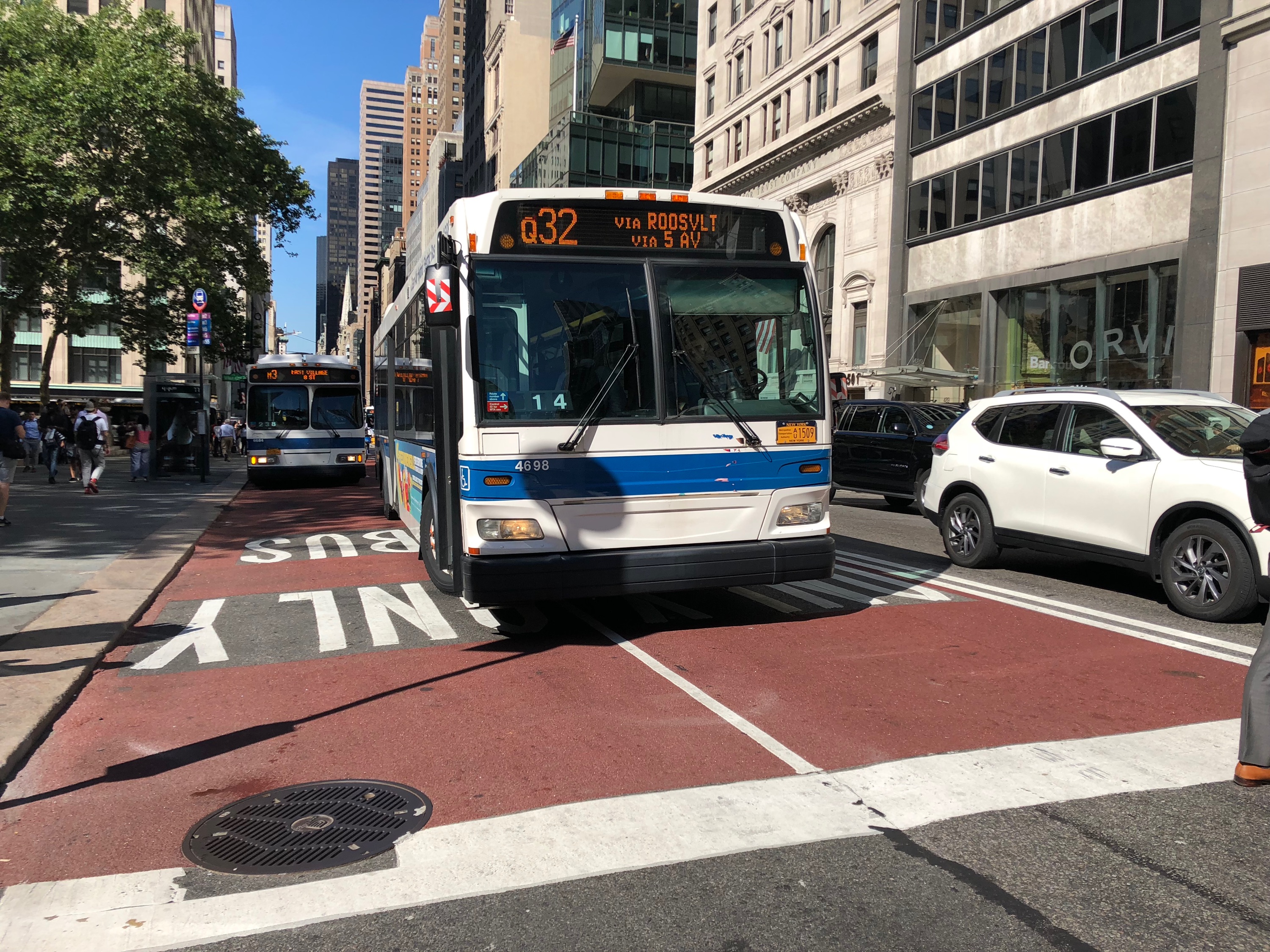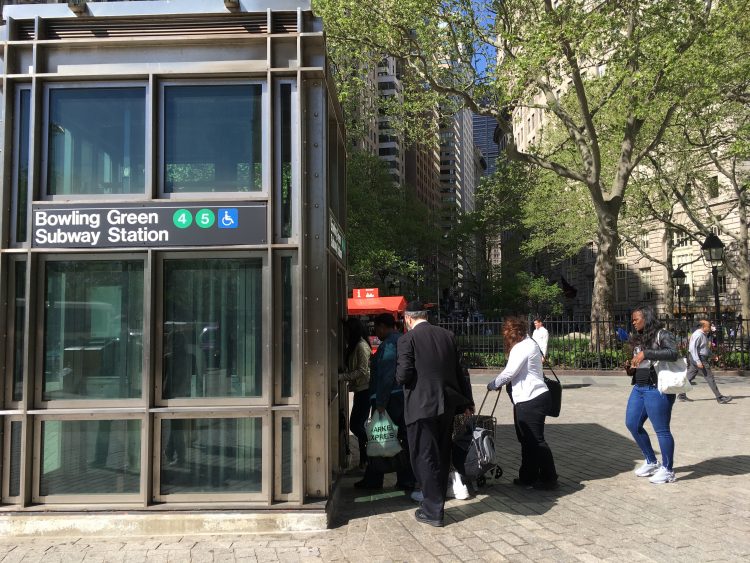
The rollout of congestion pricing should be tightly coordinated with the addition of bus lanes and implementation of all-door boarding.
With the passage of congestion pricing legislation in the state budget, Governor Andrew Cuomo harpooned the great white whale of New York transportation politics: He got a road pricing plan for New York City’s most traffic-choked streets through Albany.
Charging to drive into the congested heart of the city makes so much sense that it looked like a distinct possibility as far back as the Lindsay administration. But putting a price on driving is so politically fraught that no executive could pull it off until now.
All it took was a 12-year public messaging campaign, unprecedented advocacy mobilization, a sweeping realignment in the State Senate, and the firm commitment of the governor to make it happen.
Congestion pricing also passed because the New York City transit system is in the midst of a full-blown crisis of unreliable service and ridership loss. Victory in the budget may signal the end of the legislative campaign for congestion pricing, but it’s the start of an effective policy response to New York’s traffic and transit dysfunction.
So much of the promise of congestion pricing is conditional. Congestion pricing can catalyze a profound shift in New York’s surface transportation system to favor transit, biking, and walking — if City Hall reallocates the street space opened up by tolling. The revenue from congestion fees can make the subways more accessible and reliable — if the MTA gets its capital costs under control.
If policy makers capitalize on this potential, New Yorkers will see the passage of congestion pricing as a turning point. This should be the moment when the tide turns against traffic paralysis, when New York City buses start moving again, when subway service catches up to the standards set by global peers.
But first, delivering an effective congestion pricing system depends on the governor, the mayor, and their appointees at the MTA finishing what the state budget started.
Get the tolls right
The details of congestion pricing systems matter. Congestion pricing won’t work as traffic reduction policy if it’s hollowed out by exemptions. And it won’t work as a revenue source for transit if it’s too complex to administer efficiently.
The legislation enacted by Albany defines the parameters of a cordon boundary (Manhattan below 60th Street, excluding the FDR Drive and Route 9A on the west side of the island), a revenue target (enough for $15 billion in bonding capacity for the 2020-24 MTA capital program), and some exemptions (including a tax credit for residents of the congestion zone earning less than $60,000). It leaves the details of toll rates to be worked out later, by a panel whose recommendations will be submitted to the MTA Board for approval.
The upshot is that the potential for an effective congestion pricing system emerged from Albany intact, but it’s not guaranteed. While the political terrain is easier to negotiate from here on out, there’s not much wiggle room going forward.
Leaving Route 9A unpriced raises the costs of implementation and administration by requiring tolling installations at every cross street on the west side. The exemption for some residents of the zone will add cost, reduce revenue, and lessen the congestion-busting impact. If even more exemptions are carved out, administration will grow more complex and expensive, and the system will grow more vulnerable to gaming by insiders, like New York’s parking placards.
There’s a long lag until the toll plan is finalized at the end of 2020. Policy makers will have to hold firm against pressure for carveouts between now and then. A Swiss cheese congestion pricing program will fail to deliver the benefits New Yorkers have been promised, a scenario the governor and the mayor should strive to avoid at all costs.
Tightly coordinate congestion pricing with a bus turnaround
In London, the congestion charge enacted in 2003 was embedded in a wide-ranging package of improvements for city streets and the regional transportation network, with an emphasis on bus service. In New York, several major bus upgrades are in development, but the various strands haven’t been tied together in a tightly coordinated package with congestion pricing.
Mayor de Blasio recently pledged to roughly double the city’s rate of adding bus lanes and transit signal priority. New York City Transit is redesigning its bus network and says all-door bus boarding should be live by February, 2021. If implemented, these measures will produce faster, more reliable bus service. Congestion pricing will augment these gains by reducing traffic in the city center, while introducing what amounts to a deadline for other service improvements: By the time the tolls take effect, the bus network must be ready to absorb a shift in travel from driving to transit.
The impending congestion toll should light a fire under the mayor, the governor, and their respective transportation agencies to deliver an ambitious, well-defined suite of bus service improvements prior to the fees taking effect. It’s especially important to speed up the boarding process with citywide all-door boarding so an influx of new bus riders doesn’t drag down performance. Hitting this target would entail shifting the MTA’s previously stated timetable by just a few months.
Subway upgrades like resignaling the system will not be complete by the time congestion fees take effect, but bus improvements can be. Clear communication from the MTA and NYC DOT about how they intend to speed up buses before the tolls go live will give New Yorkers more assurance that congestion pricing is tied to tangible transit improvements.
Accelerate transit project delivery and reduce construction costs

Bringing the cost of elevator installation in line with global norms will facilitate the goals for station accessibility in the MTA’s Fast Forward plan.
The revenue raised from congestion pricing will mainly fund the MTA’s Fast Forward plan, which aims to resignal much of the subway system and make 50 stations accessible within five years. The priorities are on target, the question is whether the MTA will deliver.
The type of work in Fast Forward isn’t immune to the inflated construction costs and chronic delays that plague the MTA’s mega-projects. Adding elevators at a single station can take years, and costs appear to be significantly higher than peer systems. The resignaling of the 7 line lasted the better part of a decade and cost much more per mile than comparable Paris Metro projects. The money raised from congestion pricing must go farther than the money the MTA has spent on accessibility and modern signals to date.
If anyone can reform project delivery at New York City Transit, it’s Fast Forward architect Andy Byford, who has restored a measure of confidence in the subways with his candor about service quality and a back-to-basics approach to operations. And new MTA Chair Pat Foye’s recently announced transparency agenda, which includes an overhaul of the agency’s frustrating FOIL process, suggests a willingness to be open and accountable that will be absolutely essential to progress on cost control.
So far the MTA has convened working groups on cost containment and declared progress on measures of project management efficiency like processing change orders faster. A recent design revision to phase two of the Second Avenue Subway shaved a billion dollars off the pricetag by making use of existing tunnels and reducing excavation — a welcome and valuable effort that nevertheless falls short of bringing projected costs in line with global norms. Much more needs to be done to deliver capital upgrades cost-effectively as routine agency practice.
In addition to delivering subway and bus upgrades, expectations will be higher for every MTA division with congestion pricing in place. Every part of the New York region, including northern New Jersey and the suburban counties served by Metro-North and the LIRR, feels that it has a stake in what comes next.
During and after the legislative debate, this mainly manifested as an every-district-for-itself selfishness, with lawmakers seeking toll carveouts and transit goodies for their constituents, like fare discounts and chunks of funding for commuter rail. It’s up to advocates to harness this energy and convert it into momentum for a high-functioning, efficient transit network that delivers prosperity via reliable local bus service, fast and accessible subways, and frequent regional rail connecting city and suburb.
 On the Brink: Will WMATA’s Progress Be Erased by 2024?
On the Brink: Will WMATA’s Progress Be Erased by 2024?
The experience of being a WMATA rider has substantially improved over the last 18 months, thanks to changes the agency has made like adding off-peak service and simplifying fares. Things are about to get even better with the launch of all-door boarding later this fall, overnight bus service on some lines starting in December, and an ambitious plan to redesign the Metrobus network. But all of this could go away by July 1, 2024.
Read More Built to Win: Riders Alliance Campaign Secures Funding for More Frequent Subway Service
Built to Win: Riders Alliance Campaign Secures Funding for More Frequent Subway Service
Thanks to Riders' Alliance successful #6MinuteService campaign, New York City subway riders will enjoy more frequent service on nights and weekends, starting this summer. In this post, we chronicle the group's winning strategies and tactics.
Read More